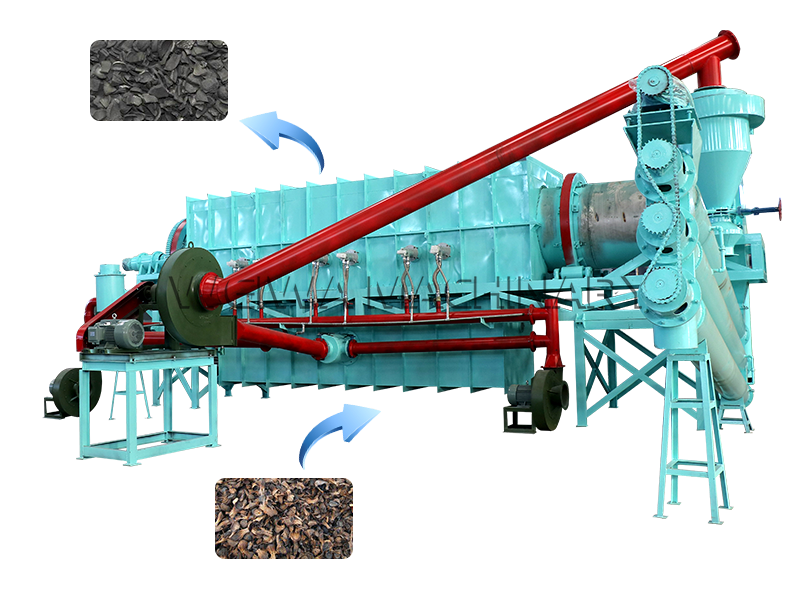Meeting Indonesia’s Growing Demand for Charcoal Production
Indonesia, with its vast palm oil industry, generates significant amounts of palm fiber—a byproduct that holds immense potential for sản xuất than. Our client, based in Indonesia, approached Máy móc Weiwa with a clear goal: to carbonize palm fiber using our continuous carbonization furnace and then process the resulting charcoal into Charcoal hookah using a hydraulic press.
Tuy nhiên, the high tar content in palm fiber posed a major challenge—leading to frequent pipeline blockages during the carbonization process. Through close collaboration, our engineering team conducted on-site debugging in Indonesia, upgrading the continuous carbonization furnace to ensure smooth operations.
Why Continuous Carbonization Furnaces Are Ideal for Palm Fiber?
The Rise of Palm Fiber as a Charcoal Feedstock
Palm fiber, a fibrous residue from palm oil production, is often discarded or underutilized. Tuy nhiên, when carbonized, it transforms into high-quality charcoal with excellent energy density—making it perfect for Charcoal hookah, BBQ briquettes, và các ứng dụng công nghiệp.
Của chúng tôicontinuous carbonization furnace for palm fiber offers:
- Hiệu quả cao with continuous feeding and discharging
- Stable temperature control for optimal carbonization
- Phát thải thấpVàenergy-saving design
Indonesia’s Need for Reliable Carbonization Technology
With Indonesia being one of the world’s largest palm oil producers, there’s a growing demand for sustainable charcoal solutions. Của chúng tôicontinuous carbonization furnace in Indonesia helps local businesses convert waste into profit while meeting environmental regulations.
Tar Buildup and Pipeline Blockages
Why Palm Fiber Causes Blockages
Palm fiber contains a high concentration of lignin and natural oils, which decompose during carbonization to form sticky tar. This tar can:
- Coat the inner walls of the furnace and pipes
- Solidify and obstruct airflow
- Reduce carbonization efficiency
Our initial tests showed that without modifications, cáccontinuous carbonization furnace would require frequent shutdowns for cleaning—leading to downtime and reduced productivity.
Our On-Site Debugging Process in Indonesia
Our team traveled to the client’s facility to:
- Analyze the carbonization flow and identify blockage points
- Inspect the furnace’s internal structure for tar accumulation
- Test different temperature and feeding rates to minimize tar formation
Upgraded Pipeline Design for Smoother Operations
Key Modifications to the Continuous Carbonization Furnace
To combat tar buildup, we implemented three major upgrades:
1. Reinforced Internal Lining & Sloped Pipelines
- We adjusted the angle of the pipelines to allow tar to flow more naturally toward collection points.
- Added heat-resistant lining to prevent tar adhesion.
2. Enhanced Airflow & Ventilation System
- Improved gas circulation to reduce tar condensation.
- Installed additional vents to release excess tar vapors before they solidified.
3. Automated Tar Collection Mechanism
- Introduced a secondary condensation chamber to capture tar before it reached critical pipes.
- This ensured cleaner gas flowVàlonger operational periods without clogging.
Results After the Upgrade
- Reduced blockages by over 80%
- Increased continuous operation time from 6 hours to 24+ giờ
- Higher charcoal yield with better quality
From Carbonization to Hookah Charcoal
Bước chân 1: Carbonizing Palm Fiber in the Continuous Furnace
- The palm fiber is fed continuously into the furnace at controlled temperatures (450–600°C).
- Cáccontinuous carbonization process ensures uniform heating and minimal tar retention.
Bước chân 2: Nghiền nát & Mixing the Charcoal
- The resulting palm fiber charcoal is crushed to a fine powder.
- Abinding agent (if needed) is mixed for optimal compression.
Bước chân 3: Hydraulic Pressing into Hookah Charcoal
- The powdered charcoal is compressed using a hydraulic press into uniform hookah briquettes.
- Our client reported higher durability and better burning performance compared to traditional charcoal.
Why Choose Weiwa Machinery for Your Carbonization Needs?
Vớiqua 30 nhiều năm kinh nghiệm in biomass carbonization, Máy móc Weiwa is a trusted partner for clients in Indonesia and beyond. Here’s what sets us apart:
Customized Solutions
- We design Lò cacbon hóa liên tục tailored to your raw materials (palm fiber, gỗ, Vỏ dừa, vân vân.).
- Our engineers provide detailed planning, drawings, and on-site support.
Professional After-Sales Service
- Our team offers remote troubleshootingVàon-site debugging when needed.
- We ensure smooth operation from installation to daily use.
Proven Track Record in Indonesia
- We’ve successfully deployed Lò cacbon hóa liên tục for multiple Indonesian clients, helping them turn waste into profitable charcoal products.
Overcoming Challenges, Delivering Results
The journey from palm fiber to hookah charcoal is not without hurdles—especially when dealing with high tar content. Tuy nhiên, through innovative engineering and on-site collaboration, Máy móc Weiwa delivered a reliable continuous carbonization furnace that now operates efficiently in Indonesia.
If you’re looking for a customized carbonization solution for palm fiber, gỗ, or other biomass, our team is ready to help.
Về Máy móc Weiwa
Với30+ nhiều năm chuyên mônTrongcharcoal making machines and carbonization technology, Máy móc Weiwa specializes in designing, chế tạo, and installing continuous carbonization furnaces for global clients. Của chúng tôiprofessional after-sales team ensures smooth operation, and we offer Giải pháp tùy chỉnh with detailed planning and on-site support.
Contact us today for a free consultation and quotation!
- Đám đông:+8613838093177
- WhatsApp:+8613838093177
- E-mail:info@cjlmachinegroup.com





 WeChat
WeChat

 +8613838093177
+8613838093177